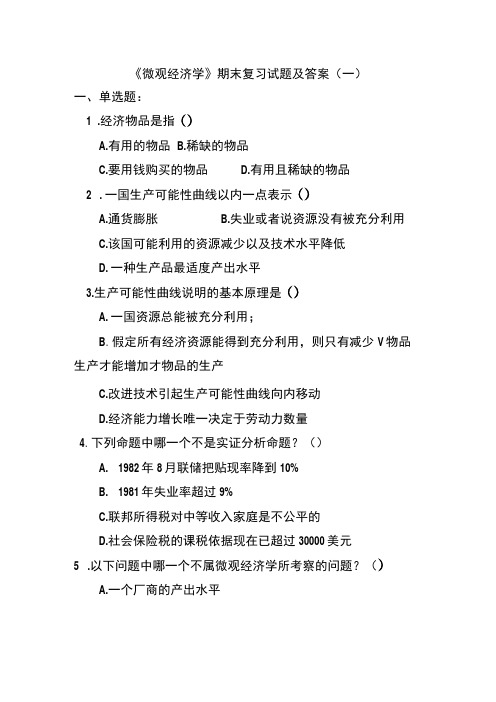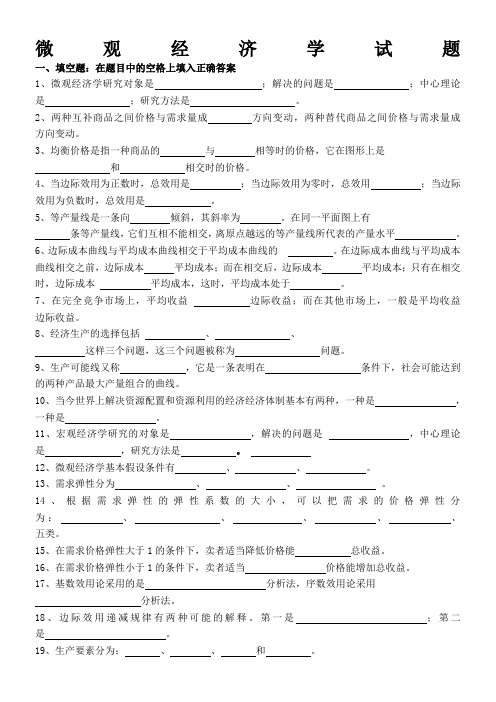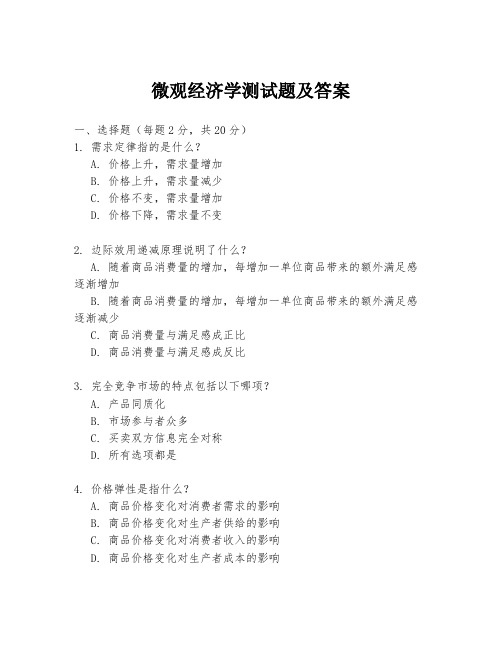华东师大微观经济学试卷(A卷)2019-6 w answers
《微观经济学》考试试卷试题及参考答案

微观经济学模拟试1一、名词解说(每题3分,共9分)2、需求的改动3.边沿利润4.花费者节余5二、选择题(每题1分,共10分)6.在得出某棉花栽种田户的供应曲线时,以下除()外均保持常数。
A.土壤的肥饶程度B.技术水平C.棉花的栽种面积D2.已知一件外衣价钱.棉花的价钱80元,一本书价钱20元,在某花费者对于这两种商品的功效最大化的平衡点上,一本书对套的边沿代替率为()A、、C、、A3.长久均匀成本曲线成为U形的原由与()。
B.规模酬劳改动有关C.外面经济与不经济有关D.因素的边沿生产率有关E.固定成本与可变为本所占比重有关4.当某花费者对商品X的花费达到饱和点时,则边沿功效MUxA、正当B、负值C、零D、不确立,需视详细状况而定5.假如在厂商的短期平衡产量上,AR小于SAC,但大于AVCA、损失,立刻停产B、损失,但连续生产C、损失,生产或不生产都能够D、获取正常利润,连续生产为(),则厂商()8.在垄断厂商的短期平衡时,垄断厂商能够()91011.两种商品在两个人之间的分派,能被称为帕累托最优的条件为()12.不使某个人受损失就不可以使另一个人得益13.个人都处在其花费契约线上14.个人都处在他们的功效可能性曲线上15.包含以上所有条件16.在厂商的停止营业点上,应当有()A.AR=AVCB .总损失等于TFCC.P=AVCD .以上说法都对9.所有以下因素除哪一种外都会使需求曲线挪动?()A.花费者收入变化B.商品价钱变化C.花费者偏好变化D.其余有关商品价钱变化10.某田户今年扩大播种面积并获得丰产,则可预期他的收入会()。
A.增添B.减少C.不变D.不确立三、判断题(每题1分,共10分)1.若某产品需求曲线向右下方倾斜,则可判断它必为正常品。
().以不同价钱销售同一种产品被称为价钱鄙视。
().只需市场价钱高于边沿成本,垄断公司必然扩大产量。
().不完好竞争市场是指整个行业中只有独一的一个厂商的市场组织。
《微观经济学》试题及参考答案大全

《微观经济学》试题及参考答案大全微观经济学试题及参考答案一、判断题1、经济学研究的是稀缺资源在无限需求者之间的分配。
( )2、无差异曲线位置高低与它的形状没有关系,它们都是由消费者偏好决定的。
( )3、价格下降导致短期供给量增加,是因为厂商拥有过多的生产要素。
( )4、市场需求是所有个别消费者需求的总和。
( )5、长期中,固定成本和可变成本没有区别。
( )6、价格等于平均收益时,企业实现最大利润。
( )7、边际产量递减规律的前提条件是所有生产要素都同比例变动。
( )8、卖方垄断和买方垄断都可能导致资源浪费。
( )9、土地的供给曲线是一条水平线。
( )10、长期平均成本曲线一定是短期平均成本曲线的包络线。
( )二、选择题1、下列说法正确的是 ( )。
A. 劣质商品的价格高于成本,使生产者不能得到正常利润,但价值是客观存在的 B. 产权不清晰会阻碍科学技术的迅速发展 C. 偶然所得不具有价值 D. 纸币和信用货币是等价的,都是一般等价物2、短期中,垄断厂商决定生产的产量和价格的方法是 ( )。
A. 最小平均成本法 B. 最大利润法 C. 最大收益法 D. 均衡法3、下列说法正确的是 ( )。
A. 当劳动的边际产量为零时,总产量最大 B. 随着某一生产要素的投入增加,其边际产量减少 C. 一种要素的边际产量减少,意味着另一种要素的边际产量减少 D. 当边际产量大于平均产量时,总产量增加4、下列说法正确的是 ( )。
A. 生活水平提高可以导致劳动力供给增加 B. 技术进步使得劳动力需求增加 C. 劳动力供给增加不包括劳动力的自愿失业 D. 在工资率变化的情况下,教育费用增加也会使劳动力供给增加减少5、下列说法正确的是 ( )。
A. 卖方垄断使社会资源使用效率下降 B. 卖方垄断使社会资源分配最为合理 C. 买方垄断使社会资源使用效率下降 D. 买方垄断使社会资源分配最为合理6、下列说法正确的是 ( )。
《微观经济学》期末复习试题及答案5套

《微观经济学》期末复习试题及答案(一)一、单选题:1 .经济物品是指()A.有用的物品B.稀缺的物品C.要用钱购买的物品D.有用且稀缺的物品2 . 一国生产可能性曲线以内一点表示()A.通货膨胀B.失业或者说资源没有被充分利用C.该国可能利用的资源减少以及技术水平降低D. 一种生产品最适度产出水平3.生产可能性曲线说明的基本原理是()A. 一国资源总能被充分利用;B.假定所有经济资源能得到充分利用,则只有减少V物品生产才能增加才物品的生产C.改进技术引起生产可能性曲线向内移动D.经济能力增长唯一决定于劳动力数量4.下列命题中哪一个不是实证分析命题?()A. 1982年8月联储把贴现率降到10%B. 1981年失业率超过9%C.联邦所得税对中等收入家庭是不公平的D.社会保险税的课税依据现在已超过30000美元5 .以下问题中哪一个不属微观经济学所考察的问题?()A.一个厂商的产出水平B.失业率的上升或下降C.联邦货物税的高税率对货物销售的影响D.某一行业中雇佣工人的数量6 .经济学家提出模型的主要理由是()A. 一个模型为验证一种假设所必需B一个模型可帮助弄清和组织对一个论点的思考过程C. 一个模型为决定一个指数所必需D.只有模型中才可使用实际变量7 .微观经济学是经济学的一个分支,主要研究( )oA.市场经济B,个体行为 C.总体经济活动 D.失业和通货膨胀等8 .宏观经济学是经济学的一个分支,主要研究( )oA.计划经济与通货膨胀C.不发达国家经济增长问题9.实证经济学(A.关注应该是什么什么,将来如何B.经济总体状况,如失业D.计算机产业的价格决定B.主要研究是什么,为C,不能提供价值判断的依据 D.对事物进行价值判断10 .下列哪一项会导致生产可能线向外移动()OA.失业B.通货膨胀C.有用性资源增加或技术进步D.消费品生产增加,资本品生产下降11 .人们在经济资源的配置和利用中要进行选择的根本原因在于()oA.产品效用的不同B.人们的主观偏好不同C,经济资源的稀缺性D,经济资源用途的不同参考答案一、单选题:1. D2. B3. B4. C5. B6. B7. B8. B9. B 10. C11. C需求、供给与均衡价格一、单项选择:1 .在得出某棉花种植农户的供给曲线时,下列除哪一个因素以外其余均保持为常数()oA. 土壤的肥沃程度B.技术水平C,棉花的种植面积D.棉花的价格2 .在下述的原因中哪个不是彩色电视机的需求曲线向左平移的原因:()oA.彩色电视机的价格上升B.消费者对彩色电视机的预期价格上升C.消费者对彩色电视机的预期价格下降D,消费者的收入水平提高3 .某月内,X商品的替代品的价格上升和互补品的价格上升,分别引起X商品的需求变动量为50单位和80单位,则在它们共同作用下该月X商品需求数量:()oA,增加30单位B,减少30单位 C.增加130单位D.减少130单位4 .如果一条线性的需求曲线与一条曲线型的需求曲线相切,则在切点处两条需求曲线的需求价格弹性系数:()oA.不相同B.相同C.可能相同,也可能不相同D.根据切点的位置而定5 .假定玉米市场的需求是缺乏弹性的,玉米的产量等于销售量且等于需求量,恶劣的气候条件使玉米产量下降20%,在这种情况下:()。
微观经济学考试试和答案

《微观经济学》课程考试题及参考答案I 阶段测试试卷《微观经济学》阶段测试试卷A一、判断题(每题1分,共15分)1. 花10元钱理发的机会成本是10元钱和用来理发的时间的其他最好的用途。
()2. 如果某个人在生产某种物品时机会成本比别人低,就可以说这个人在生产这种物品时具有比较优势。
()3. 假定其它条件不变,某商品价格下降将引起需求量的增加和供给量的减少。
()4. 假定个人电脑的需求增加而生产个人电脑的成本下降,那么就可以预期到个人电脑交易量会增加但价格可能上升也可能下降。
()5. 如果我们观察到香蕉的价格上升而交易量减少了,我们就知道香蕉的供给减少了。
()6. 如果一个人对百事可乐和可口可乐的偏爱程度相同,那么,这两物品的需求交叉弹性大。
()7. 假定A物品的需求曲线是一条直线,那么,价格越高,需求也就越富有弹性。
()8. 供给越富有弹性,买者分摊的销售税比例就越小。
()9. 效用因人因时因地的不同而不同。
()10. 市场需求是所有个人需求的总和。
()11. 消费者购买两种商品的最大效用原则是MU=λ•P()12. 均衡价格就是需求和供给相等时的价格。
()13. 生产理论中所说的短期与长期的划分依据是以实际产量能否达到计划产量为界限。
()14. 在生产规模报酬递减阶段,LAC与SAC切于SAC最低点的左边。
()15. 平均产量曲线与边际产量曲线在边际产量曲线的最高点相交。
()二、填空题(每格1分,共15分)1. 需求量随收入增加而增加的商品为,需求量随收入增加而减少的商品是。
2. 消费者购买两种商品的最大效用原则是;生产者在既定产量下的最小成本原则是。
3. 在确定成本时,会计师衡量的是成本,经济学家衡量的是成本。
4. 需求定理告诉我们,当某种物品价格上升时,其将。
5. 供给弹性衡量某种物品的对其变动的反应程度。
6. 如果某种物品提价之后总收益增加,则这种物品的需求是弹性的。
7. 只有预算线和无差异曲线上的商品组合,才是消费者获得最大满足的商品组合。
微观经济学试题附答案

微观经济学试题一、填空题:在题目中的空格上填入正确答案1、微观经济学研究对象是;解决的问题是;中心理论是;研究方法是。
2、两种互补商品之间价格与需求量成方向变动,两种替代商品之间价格与需求量成方向变动。
3、均衡价格是指一种商品的与相等时的价格,它在图形上是和相交时的价格。
4、当边际效用为正数时,总效用是;当边际效用为零时,总效用;当边际效用为负数时,总效用是。
5、等产量线是一条向倾斜,其斜率为。
在同一平面图上有条等产量线,它们互相不能相交,离原点越远的等产量线所代表的产量水平。
6、边际成本曲线与平均成本曲线相交于平均成本曲线的。
在边际成本曲线与平均成本曲线相交之前,边际成本平均成本;而在相交后,边际成本平均成本;只有在相交时,边际成本平均成本,这时,平均成本处于。
7、在完全竞争市场上,平均收益边际收益;而在其他市场上,一般是平均收益边际收益。
8、经济生产的选择包括、、这样三个问题,这三个问题被称为问题。
9、生产可能线又称,它是一条表明在条件下,社会可能达到的两种产品最大产量组合的曲线。
10、当今世界上解决资源配置和资源利用的经济经济体制基本有两种,一种是,一种是。
11、宏观经济学研究的对象是,解决的问题是,中心理论是,研究方法是。
12、微观经济学基本假设条件有、、。
13、需求弹性分为、、。
14、根据需求弹性的弹性系数的大小,可以把需求的价格弹性分为:、、、、、五类。
15、在需求价格弹性大于1的条件下,卖者适当降低价格能总收益。
16、在需求价格弹性小于1的条件下,卖者适当价格能增加总收益。
17、基数效用论采用的是分析法,序数效用论采用分析法。
18、边际效用递减规律有两种可能的解释。
第一是;第二是。
19、生产要素分为:、、和。
20、产量增加的幅度将大于规模扩大的幅度称;产量增加的幅度将等于规模扩大的幅度,称为;产量增加的幅度小于规模扩大的幅度,称为。
二、单项选择题:在所给的四个备选答案中选出一个正确答案,把所选答案的字母填入括号内。
微观经济学练习题A(附参考答案)

《微观经济学》练习题A(附参考答案)一、判断题(在正确的命题前面写“√”,在错误的命题前面写“X”;每小题1分,共10分)()1. 支持价格是政府规定的某种产品的最高价格。
()2. 经济分析中一般假定消费者的目标是效用最大化。
()3. 在一条直线型的需求曲线上每一点的需求弹性系数都不一样。
()4. 消费者均衡的实现条件是消费者花在每一元钱上的商品的边际效用都相等。
()5. 在同一平面内,两条无差异曲线是可以相交的。
()6. 规模经济和边际收益递减规律所研究的是同一个问题。
()7. 基尼系数越大,收入分配越平均。
()8. 边际成本曲线总是交于平均成本曲线的最低点。
()9. 完全竞争市场中厂商所面对的需求曲线是一条水平线。
()10. 一个博弈中存在纳什均衡,但不一定存在占优均衡。
二、选择题(下列各题中的答案只有一个是正确的,将正确答案的序号写在题前的括号内;每小题1分,共10分)()1. 在市场经济中,当鸡蛋的供给量小于需求量时,解决鸡蛋供求矛盾的下列办法中最有效的办法是:A. 实行定量供给;B. 宣传吃鸡蛋会导致胆固醇升高;C. 让鸡蛋的价格自由升高;D. 进口鸡蛋()2. 随着产量的增加,短期平均固定成本:A. 增加;B. 不变;C. 减少;D. 不能确定()3. 最需要进行广告宣传的市场是:A. 完全竞争市场;B. 完全垄断市场;C. 垄断竞争市场;D. 寡头垄断市场()4. 在消费者均衡时,消费者购买商品的总效用与他所支付的货币的总效用的关系是:A. 前者小于后者;B. 二者相等;C. 前者大于后者;D. 二者没有关系()5. 当某厂商以最小成本生产出既定产量时,此厂商:A. 总收益为零;B. 一定获得了最大利润;C. 一定未获得最大利润;D. 无法确定是否获得了最大利润()6. 下列哪一个不是完全竞争市场的特点:A. 大量的卖者和买者;B. 存在产品差别;C. 资源完全流动;D. 完全信息()7. 垄断竞争市场中厂商达到短期均衡的产量的条件是,在该产量处:A. 两条需求相交;B. SMC=MR;C 同时符合A和B; D. LMC=MR()8. 完全垄断市场中厂商的边际收益曲线:A. 和需求曲线重合;B. 是一条水平线;C. 在需求曲线上方;D. 在需求曲线下方()9. 在古诺双垄断模型处于均衡时,每个厂商提供潜在市场容量的:A. 1/3;B. 1/2;C. 2/3;D. 1()10. 卡特尔制定统一价格的原则是:A. 使整个卡特尔产量最大;B. 使整个卡特尔利润最大;C. 使整个卡特尔的边际成本最小;D. 使整个卡特尔中各厂商的利润最大三、计算题(每小题10分,共20分)1. 设汽油的需求价格弹性是0.15,现价格为每加仑1.20美元,试问汽油价格上涨到多少美元一加仑才能使其消费量减少10%?2. 若厂商面对的需求曲线是 Q= -P +50 ,分别求出厂商的总收益曲线. 边际收益曲线和平均收益曲线?五、简答题(每小题10分,共30分)1. 什么是生产要素边际报酬递减规律?2. 简述供求定理的内容?3. 形成完全垄断的原因主要有哪些?六、分析说明题:(共30分)1. 结合我国民航业和通讯业的实际,说明打破垄断促进竞争的意义。
微观经济学考试题库(含答案完整版)

微观经济学考试题库(含答案完整版)第一章引论一、单选题(70题)1. 下列哪一种资源是最别具有稀缺性的?()A.大夫;B.苹果;C.铁矿石;D.空气;2. 下列中的哪一具咨询题是最有也许被微观经济学家所研究的?()A. 普通物价的膨胀;B. 整个经济中的失业;C. 总产出的增长率;D. 汽车行业中的劳动就业;3. 下列中的哪一具属于规范经济咨询题? ()A. 通货膨胀和失业是由啥引起的?B. 政府应该雇用所有失业的工人吗?C. 消费者怎么对较低的价格做出反应?D. 收入与储蓄之间的关系是啥?4. 经济学有时被称作社会科学的皇后,这是因为:()A.它强调经济增长和经济进展;B. 几乎所有的学生都必须学习经济学;C. 它的边际分析办法广泛应用于其他学科;D. 规范经济学和实证经济学的区不。
5. 经济学家的理性行为假定:()A.仅仅在其提供有效预测的限度内才是实用的。
B.导致错误的理论,因为人们并非总是理性的。
C.惟独当所有人基本上理性的,才是实用的。
D.别管人们是否为理性的,基本上有效的。
6. 微观经济学研究(),宏观经济学研究()。
A.现实的经济咨询题,抽象的经济理论;B.个量经济,总量经济 C.理性行为,非理性行为;D.企业行为,政府行为7.经济学可定义为()。
A.政府对市场制度的干预 B.企业赚取利润的活动C.研究稀缺资源怎么有效配置的咨询题D.个人的生财之道8.“资源是稀缺的”是指()A.资源是别可再生的 B.资源必须留给下一代C.资源终将被耗费殆尽D.相关于需求而言,资源总是别脚的.9.失业咨询题假如反映在生产也许性曲线图上,可记为()A.生产也许性曲线内的一点 B.生产也许性曲线上的一点C.生产也许性曲线以外的一点D.别在该平面直角坐标系上.10.下列哪一项会导致一国生产也许性曲线的外移?()A.股市持续走强 B.通货膨胀C.实用资源被发掘或技术进步D.消费品生产增加,资本品生产下落. 11.一具经济体系必须作出的基本挑选是()。
微观经济学测试题及答案

微观经济学测试题及答案一、选择题(每题2分,共20分)1. 需求定律指的是什么?A. 价格上升,需求量增加B. 价格上升,需求量减少C. 价格不变,需求量增加D. 价格下降,需求量不变2. 边际效用递减原理说明了什么?A. 随着商品消费量的增加,每增加一单位商品带来的额外满足感逐渐增加B. 随着商品消费量的增加,每增加一单位商品带来的额外满足感逐渐减少C. 商品消费量与满足感成正比D. 商品消费量与满足感成反比3. 完全竞争市场的特点包括以下哪项?A. 产品同质化B. 市场参与者众多C. 买卖双方信息完全对称D. 所有选项都是4. 价格弹性是指什么?A. 商品价格变化对消费者需求的影响B. 商品价格变化对生产者供给的影响C. 商品价格变化对消费者收入的影响D. 商品价格变化对生产者成本的影响5. 以下哪项不是市场失灵的原因?A. 公共物品B. 外部性C. 垄断D. 消费者偏好6. 机会成本是指什么?A. 做出选择时放弃的最低价值选项B. 做出选择时放弃的最高价值选项C. 做出选择时放弃的所有选项的总价值D. 做出选择时放弃的最低成本选项7. 消费者剩余是指什么?A. 消费者支付的价格与商品价值之间的差额B. 消费者支付的价格与商品成本之间的差额C. 消费者支付的价格与商品供给价格之间的差额D. 消费者支付的价格与商品边际成本之间的差额8. 短期成本与长期成本的区别是什么?A. 短期成本包括固定成本和可变成本,长期成本只包括可变成本B. 短期成本只包括固定成本,长期成本包括固定成本和可变成本C. 短期成本只包括可变成本,长期成本包括固定成本和可变成本D. 短期成本和长期成本没有区别9. 完全垄断市场的特征是什么?A. 市场上只有一个卖者B. 产品具有独特性C. 进入市场存在障碍D. 所有选项都是10. 价格歧视是指什么?A. 根据消费者的支付意愿不同,对同一商品或服务收取不同的价格B. 根据消费者的收入水平不同,对同一商品或服务收取不同的价格C. 根据消费者的年龄不同,对同一商品或服务收取不同的价格D. 根据消费者的职业不同,对同一商品或服务收取不同的价格二、简答题(每题10分,共20分)1. 请简述边际成本和平均成本的区别及其在企业决策中的作用。
- 1、下载文档前请自行甄别文档内容的完整性,平台不提供额外的编辑、内容补充、找答案等附加服务。
- 2、"仅部分预览"的文档,不可在线预览部分如存在完整性等问题,可反馈申请退款(可完整预览的文档不适用该条件!)。
- 3、如文档侵犯您的权益,请联系客服反馈,我们会尽快为您处理(人工客服工作时间:9:00-18:30)。
华东师范大学期末试卷(A)ECNU Final Exam (A)2018——2019学年第2学期2nd Semester, 2018-2019 课程名称Course Name:学生姓名Student Name:学号Student ID:专业Major:年级/班级Class:课程性质:公共必修√、公共选修、专业必修、专业选修1 Multiple Choice (Pick one answer for each question. 5 points each)1) ________ are sources of market failure.A) Private goods B) Competitive activities C) Externalities D) All of the above are correct.2) Assume that the price underestimates the value that society places on the flu vaccine. If firms produce where P = MC, firms will be producing ________ the socially efficient amount of flu vaccine.A) exactlyB) more thanC) less thanD) sometimes more than and sometimes less than3) Suppose you know that the breakfast cereal industry is characterized by significant ʺbarriers to entryʺ. Which of the following is a correct inference?A) Economic profits in the breakfast cereal industry are likely to persist, ceteris paribus.B) The breakfast cereal industry could be an unregulated, perfectly competitive industry.C) The government must be artificially restricting entry into the breakfast cereal industry.D) The breakfast cereal industry is producing a type of public good.4) Which model of oligopoly results in the greatest efficiency?A) oligopoly competition in price with differentiated productsB) oligopoly competition in price with homogeneous productsC) oligopoly competition in quantity with homogeneous productsD) oligopoly competition with collusion5) All of the following are characteristics of monopolistically competitive industries EXCEPT:A) There are no barriers to entry B) Strategic behavior C) Product differentiation D) A large number of firms6) Refer to the above table. Firm Aʹs dominant strategy isA) to advertise.B) to not advertise.C) dependent on what Firm B does.D) indeterminate from this information, as no information is provided on Firm Aʹs risk preference.7) When a sales tax is imposed on the sellers,A) only sellers pay the taxB) sellers and buyers share the tax according to their price elasticitiesC) only buyers pay the taxD) none of the above8) Private goods are ________ in consumption and their benefits are ________.A) rival; excludableB) nonrival; excludableC) nonrival; nonexcludableD) rival; nonexcludable9) You own the only stall selling orange juice in a school cafeteria. Your cost for producing one cup of orange juice is $1. Currently, you are charging the same price for one cup of orange juice from every student. If the demand function is p=11-q. What is your profit maximizing price?A) $10B) $9C) $6D) $110) (continuing the last question) You discover that students after PE class buy more orange juice from you. On the other hand, students after a class on calculus appear to be neutral to buying the orange juice. What type of pricing strategy should you use to maximize your profit?A) charging uniform priceB) practice first degree price discriminationC) practice second degree price discriminationD) practice third degree price discrimination2. Long Questions (Please write down how you get your answers.)11) (25 points) suppose the government pays $2 to the buyers of a good for each unit of the good they purchase. The diagram below shows the demand and supply for this good.a) (5 points) What is the original consumer surplus without subsidy?b) (5 points) What is the original producer surplus without subsidy?c) (5 points) What is the consumer surplus after the subsidy is given?d) (5 points) What is the producer surplus after the subsidy is given?e) (5 points) Will your answers change if the subsidy is given to the producers instead of the buyers?(You can use letter, for example, A+B, to answer these questions.)Answer:a) The original consumer surplus without subsidy is A+B.b) The original producer surplus without subsidy is D+E.c) The consumer surplus after the subsidy is given is A+B+D+F+H.d) The producer surplus after the subsidy is given is B+D+E+C.e) The answers will not change if the subsidy is given to the producers instead of the buyers, because of the neutrality of subsidy.12) (25 points) There are two firms producing robots in a market. Each firm has two options: producing high quality robots or producing low quality robots. If both firms produce high quality robots, each firm gets a profit of $500. If both firms produce low quality robots, each firm gets a profit of $400. If firm A produces high quality robots and firm B produces low quality robots, firm A gets $800 and firm B gets $600. If firm A produces low quality robots and firm B produces high quality robots, firm A gets $600 and firm B gets $800.a) (5 points) If the two firms make decisions simultaneously, please draw the payoff matrix.b) (5 points) Is there any dominant strategy in this game?c) (5 points) Is there any pure strategy Nash equilibrium in this game?d) (5 points) If firm A makes decision first and firm B makes decision after observing firm A’s decision, please draw the game tree.e) (5 points) What is the subgame perfect equilibrium of this sequential move game?Answer:b) There is no dominant strategy in this game.c) There are two pure strategy Nash equilibria in this game: (high quality, low quality) and (low quality, high quality).d) high quality high qualityFirm A----------------- Firm B-----------------(500,500)| || low quality | low quality| || high quality (800,600)Firm B-----------------(600,800)|| low quality|(400,400)e) The subgame perfect equilibrium of this sequential move game is (high quality, low quality).华东师范大学期末试卷(A)ECNU Final Exam (A)2018——2019学年第2学期2nd Semester, 2018-2019课程名称Course Name:学生姓名Student Name:学号Student ID:专业Major:年级/班级Class:课程性质:公共必修√、公共选修、专业必修、专业选修。
